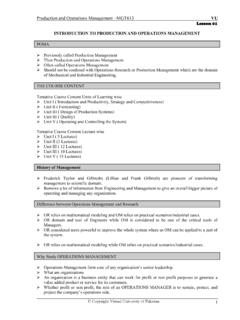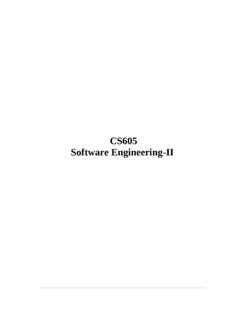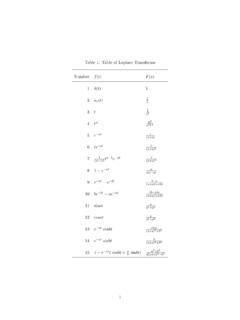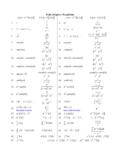Transcription of Calculus II - vulms.vu.edu.pk
1 Calculus II MTH301 Virtual University of Pakistan Knowledge beyond the boundaries Copyright Virtual University of Pakistan 1 Table of Contents Lecture No. 1 Introduction ..3 Lecture No. 2 Values of function ..7 Lecture No. 3 Elements of three dimensional geometry ..11 Lecture No. 4 Polar co-ordinates ..17 Lecture No. 5 Limits of multivariable Lecture No. 6 Geometry of continuous functions ..31 Lecture No. 7 Geometric meaning of partial ..38 Lecture No. 8 Euler 42 Lecture No .9 Examples ..48 Lecture No. 10 Introduction to vectors ..53 Lecture No. 11 The triple scalar product or Box product.
2 62 Lecture No. 12 Tangent Planes to the surfaces ..69 Lecture No. 13 Noarmal Lines ..76 Lecture No. 14 Extrema of function of two ..83 Lecture No. 15 Examples ..87 Lecture No. 16 Extreme Valued Theorm ..93 Lecture No. 17 ..98 Lecture No. 18 Revision Of Integration ..105 Lecture No. 19 Use of Lecture No. 20 Double integral for non-rectangular region ..113 Lecture No. 21 Examples ..117 Lecture No. 22 Examples ..121 Lecture No. 23 Polar co-ordinate systems ..124 Lecture No. 24 Sketching ..128 Lecture No. 25 Double Integrals in Polar co-ordinates ..133 Lecture No. 26 Examples ..137 Lecture No. 27 Vector Valued Functions ..140 Lecture No. 28 Limits Of Vector Valued Functions.
3 144 Lecture No. 29 Change Of Parameter ..150 Lecture No. 30 Exact Differential ..155 Lecture No. 31 Line Intagral ..161 Lecture No. 32 Examples ..166 Lecture No. 33 Examples ..170 Lecture No. 34 Examples ..174 Lecture No. 35 Definite ..181 Lecture No. 36 Scalar Lecture No. 37 Examples ..188 Lecture No. 38 Vector Filed ..192 Lecture No. 39 Periodic Lecture No. 40 Fourier Series ..201 Lecture No. 41 Examples ..206 Lecture No. 42 Examples ..212 Lecture No. 43 Functions with periods other than 2 ..217 Lecture No. 44 Laplace Transforms ..222 Lecture No. 45 ..227 Copyright Virtual University of Pakistan 21-Introduction VU Lecture No-1 Introduction Calculus is the mathematical tool used to analyze changes in physical quantities.
4 Calculus is also Mathematics of Motion and Change. Where there is motion or growth, where variable forces are at work producing acceleration, Calculus is right mathematics to apply. Differential Calculus Deals with the Problem of Finding (1)Rate of change. (2)Slope of curve. Velocities and acceleration of moving bodies. Firing angles that give cannons their maximum range. The times when planets would be closest together or farthest apart. Integral Calculus Deals with the Problem of determining a Function from information about its rates of Change. Integral Calculus Enables Us (1) To calculate lengths of curves. (2) To find areas of irregular regions in plane. (3) To find the volumes and masses of arbitrary solids (4) To calculate the future location of a body from its present position and knowledge of the forces acting on it.
5 Reference Axis System Before giving the concept of Reference Axis System we recall you the concept of real line and locate some points on the real line as shown in the figure below, also remember that the real number system consist of both Rational and Irrational numbers that is we can write set of real numbers as union of rational and irrational numbers. Here in the above figure we have locate some of the rational as well as irrational numbers and also note that there are infinite real numbers between every two real numbers. Now if you are working in two dimensions then you know that we take the two mutually perpendicular lines and call the horizontal line as x-axis and vertical line as y-axis and where these lines cut we take that point as origin.
6 Now any point on the x-axis will be denoted by an order pair whose first element which is also known as abscissa is a real number and other element of the order pair which is also known as ordinate will has 0 values. Similarly any point on the y-axis can be representing by an order pair. Some points are shown in the figure below. Also note that these lines divide the plane into four regions, First ,Second ,Third and Fourth quadrants respectively. We take the positive real numbers at the right side of the origin and negative to the left side, in the case of x-axis. Similarly for y-axis and also shown in the figure. Copyright Virtual University of Pakistan 31-Introduction VU Location of a point Now we will illustrate how to locate the point in the plane using x and y axis.
7 Draw two perpendicular lines from the point whose position is to be determined. These lines will intersect at some point on the x-axis and y-axis and we can find out these points. Now the distance of the point of intersection of x-axis and perpendicular line from the origin is the X-C ordinate of the point P and similarly the distance from the origin to the point of intersection of y-axis and perpendicular line is the Y-coordinate of the point P as shown in the figure below. In space we have three mutually perpendicular lines as reference axis namely x ,y and z axis. Now you can see from the figure below that the planes x= 0 ,y=0 and z=0 divide the space into eight octants. Also note that in this case we have (0,0,0) as origin and any point in the space will have three coordinates.
8 Copyright Virtual University of Pakistan 41-Introduction VU Sign of co-ordinates in different octants First of all note that the equation x=0 represents a plane in the 3d space and in this plane every point has its x-coordinate as 0, also that plane passes through the origin as shown in the figure above. Similarly y=0 and z=0 are also define a plane in 3d space and have properties similar to that of x= that these planes also pass through the origin and any point in the plane y=0 will have y-coordinate as 0 and any point in the plane z=0 has z-coordinate as 0. Also remember that when two planes intersect we get the equation of a line and when two lines intersect then we get a plane containing these two lines.
9 Now note that by the intersection of the planes x=0 and z=0 we get the line which is our y-axis. Also by the intersection of x=0 and y=0 we get the line which is z-axis, similarly you can easily see that by the intersection of z=0 and y=0 we get line which is x-axis. Now these three planes divide the 3d space into eight octants depending on the positive and negative direction of axis. The octant in which every coordinate of any point has positive sign is known as first octant formed by the positive x, y and z axis. Similarly in second octant every points has x-coordinate as negative and other two coordinates as positive correspond to negative x-axis and positive y and z axis. Now one octant is that in which every point has x and y coordinate negative and z-coordinate positive, which is known as the third octant.
10 Similarly we have eight octants depending on the sign of coordinates of a point. These are summarized below. First octant (+, +, +) Formed by positive sides of the three axis. Second octant (-, +, + ) Formed by ve x-axis and positive y and z-axis. Third octant ( -, -, +) Formed by ve x and y axis with positive z-axis. Fourth octant ( +, -, +) Formed by +ve x and z axis and ve y-axis. Fifth octant (+, +, -) Formed by +ve x and y axis with -ve z-axis. Sixth octant ( -, +, -) Formed by ve x and z axis with positive y-axis. Seventh octant ( -, -, -) Formed by ve sides of three axis. Eighth octant ( +, -, -) Formed by -ve y and z-axis with +ve x-axis. (Remember that we have two sides of any axis one of positive values and the other is of negative values) Now as we told you that in space we have three mutually perpendicular lines as reference axis.











